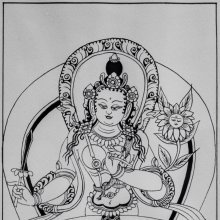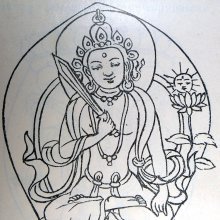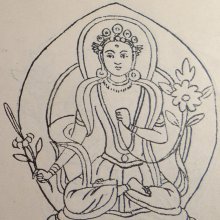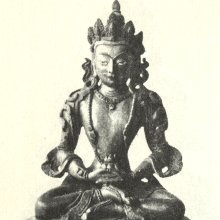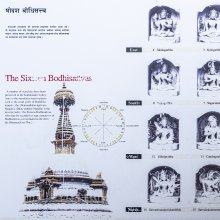Jaliniprabha, Jālinīprabha: 4 definitions
Introduction:
Jaliniprabha means something in Buddhism, Pali, Hinduism, Sanskrit. If you want to know the exact meaning, history, etymology or English translation of this term then check out the descriptions on this page. Add your comment or reference to a book if you want to contribute to this summary article.
Images (photo gallery)
(+1 more images available)
In Buddhism
Tibetan Buddhism (Vajrayana or tantric Buddhism)
Source: Wisdom Library: MañjuśrīnāmasaṃgītiJālinīprabha (जालिनीप्रभ) is one of the sixteen bodhisattvas appearing in the Vajradhātu-mahāmaṇḍala, according to the Nāmamantrārthāvalokinī v5.38-41. The Nāmamantrārthāvalokinī (literally, ‘an explanation of the nāma-mantras’) is a commentary (ṭīkā) on the 8th century Mañjuśrīnāmasaṃgīti.
Jālinīprabha is a name of Mañjuśrī (the embodiement of non-dual knowledge) and, together with other names, forms the core essence of the Mañjuśrīnāmasaṃgīti. The Nāmamantrārthāvalokinī provides the practitioner a sādhana (‘meditative practice’) to turn these names into mantras. These mantras are chanted for the benefit of all beings, and then placed and contemplated in the Vajradhātu-mahāmaṇḍala, which is an extended version of the Vajradhātu-maṇḍala.
Source: archive.org: The Indian Buddhist Iconography1) Jālinīprabha (जालिनीप्रभ) (“light of the sun”) is the name of a Bodhisattva commonly depicted in Buddhist Iconography, and mentioned in the 11th-century Niṣpannayogāvalī of Mahāpaṇḍita Abhayākara.—his color is red; his symbol is the sun-disc. Jālinīprabha is also known by the name of Sūryaprabha.
Jālinīprabha is described in the Niṣpannayogāvalī as follows:—
(1: Mañjuvajra-maṇḍala):—“Jālinīprabha is of red colour. He holds the disc of the sun on alotus in the left hand while the right displays the Varada-mudrā”. (2: Dharmadhatūvāgīśvara-maṇḍala):—“Jālinīprabha is whitish-red in complexion. He holds the sword in the right hand and the disc of the sun on a lotus in the left hand”. (3: Durgatipariśodhana-maṇḍala):—“Jālinīprabha is red in colour. He holds the Vajrapañjara (Vajra marked cage) in the right hand while the clenched left rests on the hip”.
Jālinīprabha or Sūryaprabha is sometimes seen accompanying Mañjuśrī, as depicted in Buddhist Iconography.—[...] Sometimes Mañjuśrī is accompanied only by Yamāri, sometimes only by his Śakti or female counterpart, sometimes by Sudhanakumāra and Yamāri and sometimes again by the four divinities, Jālinīprabha (also called Sūryaprabha), Candraprabha, Keśinī and Upakeśinī. Though the last four are required to be present with Arapacana, they are nevertheless found in others also.
2) Jālinīprabha (जालिनीप्रभ) or Jālinīprabhalokeśvara refers to number 42 of the 108 forms of Avalokiteśvara found in the Machhandar Vahal (Kathmanu, Nepal). [Machhandar or Machandar is another name for for Matsyendra.].
Accordingly,—
“Jālinīprabha also is one-faced and two-armed and sits in the Vajraparyaṅka attitude on a lotus. He holds the sword on a lotus in his right hand and the stem of a lotus against his chest with his left”.
The names of the 108 deities [viz., Jālinīprabha] possbily originate from a Tantra included in the Kagyur which is named “the 108 names of Avalokiteshvara”, however it is not yet certain that this is the source for the Nepali descriptions.Source: Brill: Śaivism and the Tantric Traditions (tantric Buddhism)
Jālinīprabha (जालिनीप्रभ) refers to one of the sixteen Bhadrakalpa Bodhisattvas, according to the Niṣpannayogāvalī 44ff and Abhayākaragupta’s Durgatipariśodhana-maṇḍala (Cf. Niṣpannayogāvalī 66ff.).—A set of sixteen Bodhisattvas often supplements the deities of the Tattvasaṃgraha in later Vajradhātu-maṇḍala descriptions. These are generally the sixteen Bodhisattvas of the present aeon (bhadrakalpa) [e.g., Jālinīprabha], as described for example in Abhayākaragupta’s Niṣpannayogāvalī Vajradhātu-maṇḍala.—Cf. also Nāmamantrārthāvalokinī and Abhayākaragupta’s forty-three deity Mañjuvajra-maṇḍala (Tricatvāriṃśadātmakamañjuvajra-maṇḍala: see Niṣpannayogāvalī 50)

Tibetan Buddhism includes schools such as Nyingma, Kadampa, Kagyu and Gelug. Their primary canon of literature is divided in two broad categories: The Kangyur, which consists of Buddha’s words, and the Tengyur, which includes commentaries from various sources. Esotericism and tantra techniques (vajrayāna) are collected indepently.
Languages of India and abroad
Sanskrit dictionary
Source: Cologne Digital Sanskrit Dictionaries: Edgerton Buddhist Hybrid Sanskrit DictionaryJālinīprabha (जालिनीप्रभ).—name of a Bodhisattva: Mahāvyutpatti 705. Tibetan renders jālinī by dra ba, net, or dra ba can, having a net. Perhaps having seductive (alluring) splendor ? See s.v. jālinī, which otherwise = tṛṣṇā.
Sanskrit, also spelled संस्कृतम् (saṃskṛtam), is an ancient language of India commonly seen as the grandmother of the Indo-European language family (even English!). Closely allied with Prakrit and Pali, Sanskrit is more exhaustive in both grammar and terms and has the most extensive collection of literature in the world, greatly surpassing its sister-languages Greek and Latin.
See also (Relevant definitions)
Starts with: Jaliniprabhalokeshvara.
Full-text: Suryaprabha, Jaliniprabhalokeshvara, Upakeshini, Bodhisattva, Kesini, Sudhanakumara, Siddhaikavira, Manjushri, Yamari, Candraprabha.
Relevant text
Search found 3 books and stories containing Jaliniprabha, Jālinīprabha; (plurals include: Jaliniprabhas, Jālinīprabhas). You can also click to the full overview containing English textual excerpts. Below are direct links for the most relevant articles:
The Indian Buddhist Iconography (by Benoytosh Bhattachacharyya)
Figure 60 - Bodhisattva Jālinīprabha
108 forms of Avalokiteśvara (42): Jālinīprabha Lokeśvara
Maha Prajnaparamita Sastra (by Gelongma Karma Migme Chödrön)
Part 4 - Illuminating the darkness of the intermediary worlds < [Chapter LI - Seeing all the Buddha Fields]
III. Fruits of the immeasurables (apramāṇa) < [Class 3: The four immeasurables]
Vimalakirti Nirdesa Sutra (by Robert A. F. Thurman)
